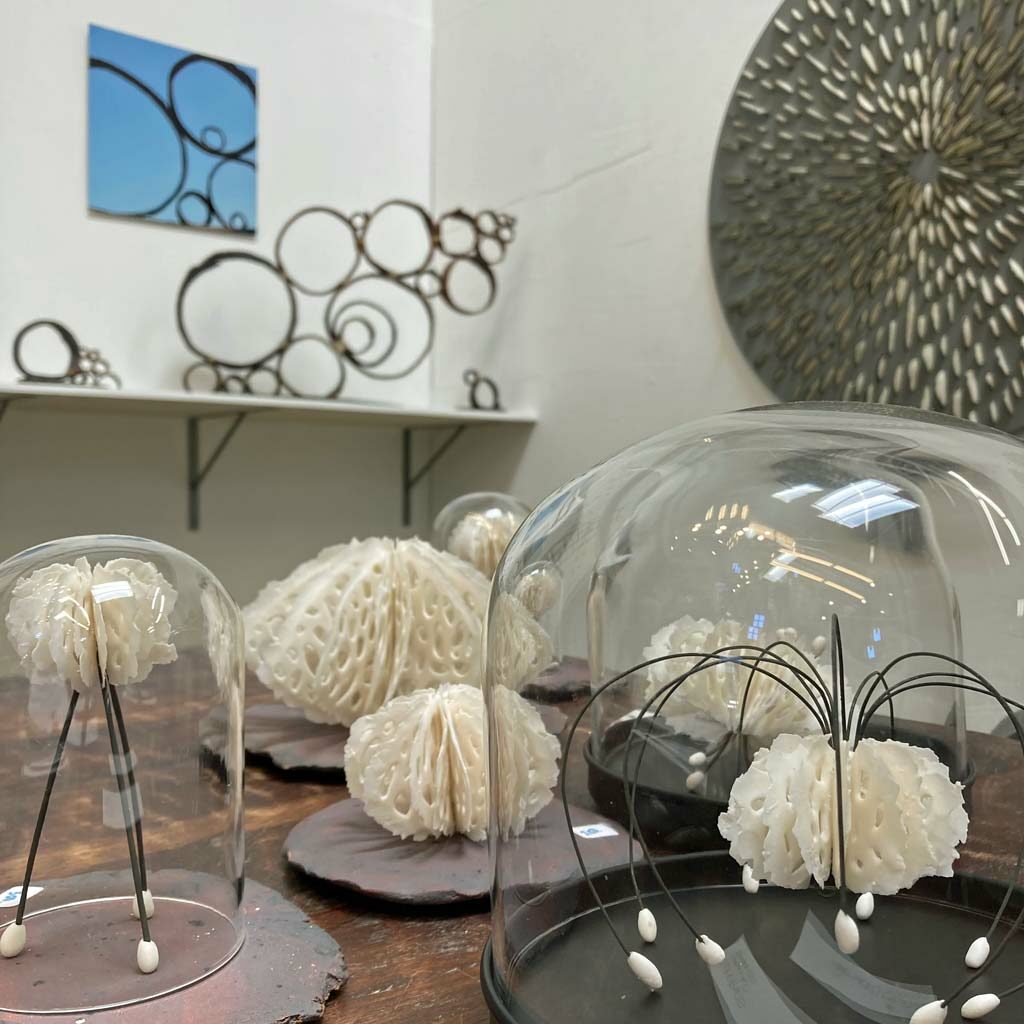
OCTOBER 1, 2, 15 & 16
OPEN 10-5
2523 C MISSION ST SANTA CRUZ
ARTIST #26 IN THE CATALOG
Lots of goodies will be available! See you this weekend!!
For more info about this event visit: santacruzopenstudios.com

OCTOBER 1, 2, 15 & 16
OPEN 10-5
2523 C MISSION ST SANTA CRUZ
ARTIST #26 IN THE CATALOG
Lots of goodies will be available! See you this weekend!!
For more info about this event visit: santacruzopenstudios.com
Thank you to everyone who came up to see the opening of Bodies of Water at the Eloise Pickard Smith Gallery- it was a lovely evening celebrating a collaboration of art + science. If you missed the opening, I wanted to share images of the ephemeral ice sculpture that was on display in the courtyard.
Throughout the course of the evening, discs of ice with porcelain plankton parts embedded in them calved, crashed, slipped and dripped as the installation melted away. A blatant commentary on the loss of sea ice, rising ocean temperatures and how we are all contributing to it. Accompanying the ice sculpture were words by Ari Friedlaender, PhD who has seen climate change happening in front of his eyes over multiple trips to Antartica. Inside the gallery, three pieces made with resin mimicked the ephemeral ice sculpture melting outside.
Our planet is warming, quickly. Some regions like those at the poles are extremely susceptible to warming. In both the Arctic and Antarctic, nearly every level of the marine ecosystem has evolved to rely on the annual advance and retreat of sea ice. The intimate ties between sea ice and the health of our oceans are being stretched thin by rapid warming and diminishing amounts of sea ice cover. From tiny bacteria and phytoplankton that rely on the sea ice for their growth and flourishing, to zooplankton like krill that feed on these under-ice communities, to the largest animals on the planet the baleen whales that feed on these zooplankton, they are all at risk. Scientists and the general public can see these changes occur from satellite images, documentary films, scientific reports, and first-hand accounts.
Over the past 25 years I have made nearly 50 trips to the Antarctic Peninsula, the knife-edge of the continent that sits below South America and juts into the Southern Ocean. Here, temperatures are warming as fast as nearly anywhere on the planet, and the amount of sea ice that builds annually is decreasing. Because of this, the amount of krill that is available for penguins, seals, seabirds, fish, and whales is decreasing too. Above the water, I have watched as glaciers curl up like a hermit crab into its shell, I have watched glossy snow-covered peaks weep away their cover becoming dark, rocky outcroppings, and I have watched as the surface of the ocean that should be frozen solid remains liquid and wavy.
Opportunities to share these stories and bring together people from diverse communities with different ways of thinking and seeing the world is critical if we are to find a way to solve these issues that we have, without a shadow of a doubt, created by our actions. Art and science are two powerful tools that we have to educate, bring empathy, share truth, and inspire change. I am honored to be part of this effort with Jenni and Tauna and all of these here at UCSC.
Ari S. Friedlaender, PhD
Professor, Ocean Sciences Department
It was the first time I’d used ice as a medium and as simple as it seems to make ice, there was actually a very steep learning curve. I had to make the ice as clear as possible, I wanted to suspend the ceramic pieces in it at different layers and I wanted to display them in a way that worked with the exhibit as a whole.
I honestly didn’t advertise that I was planning this for the opening because I really wasn’t sure if it would work or if it would be interesting or if it would melt before anyone even got there. The lighting added another element that helped highlight the the porcelain plankton and the natural bubble patterns in the ice. By the end of the night, very little of the ice remained. And while it didn’t turn out exactly like my plan, it was beautiful and interesting and I think it has a lot of potential for future projects.
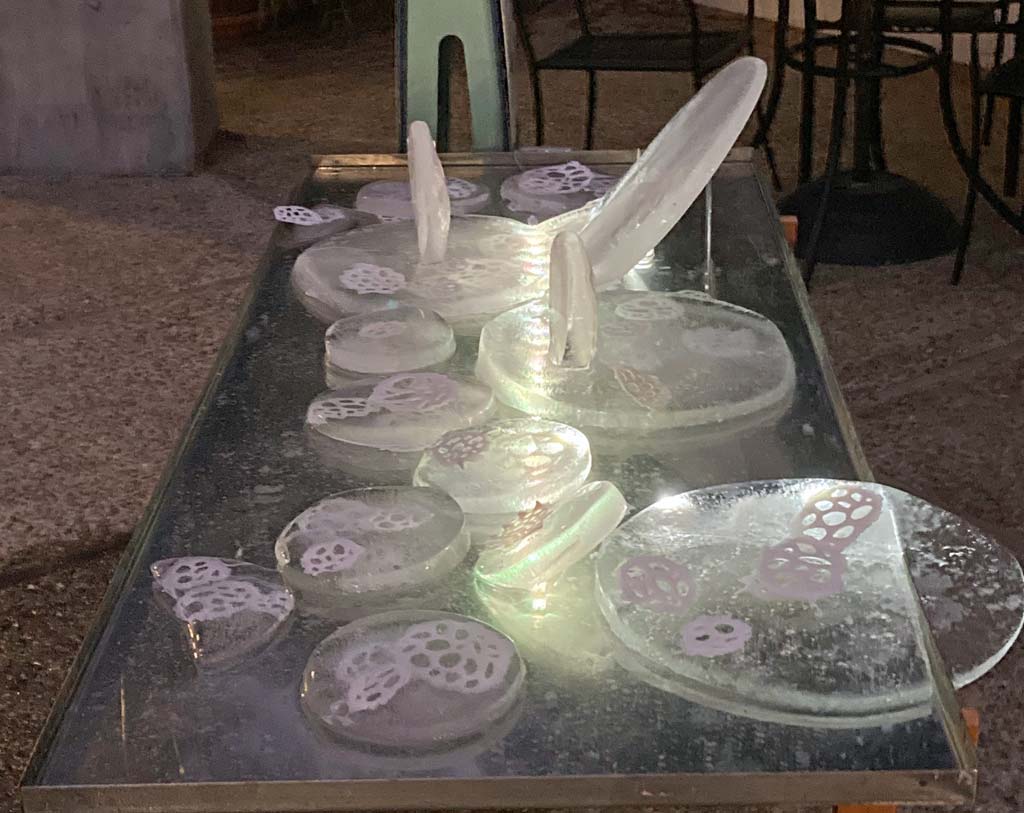
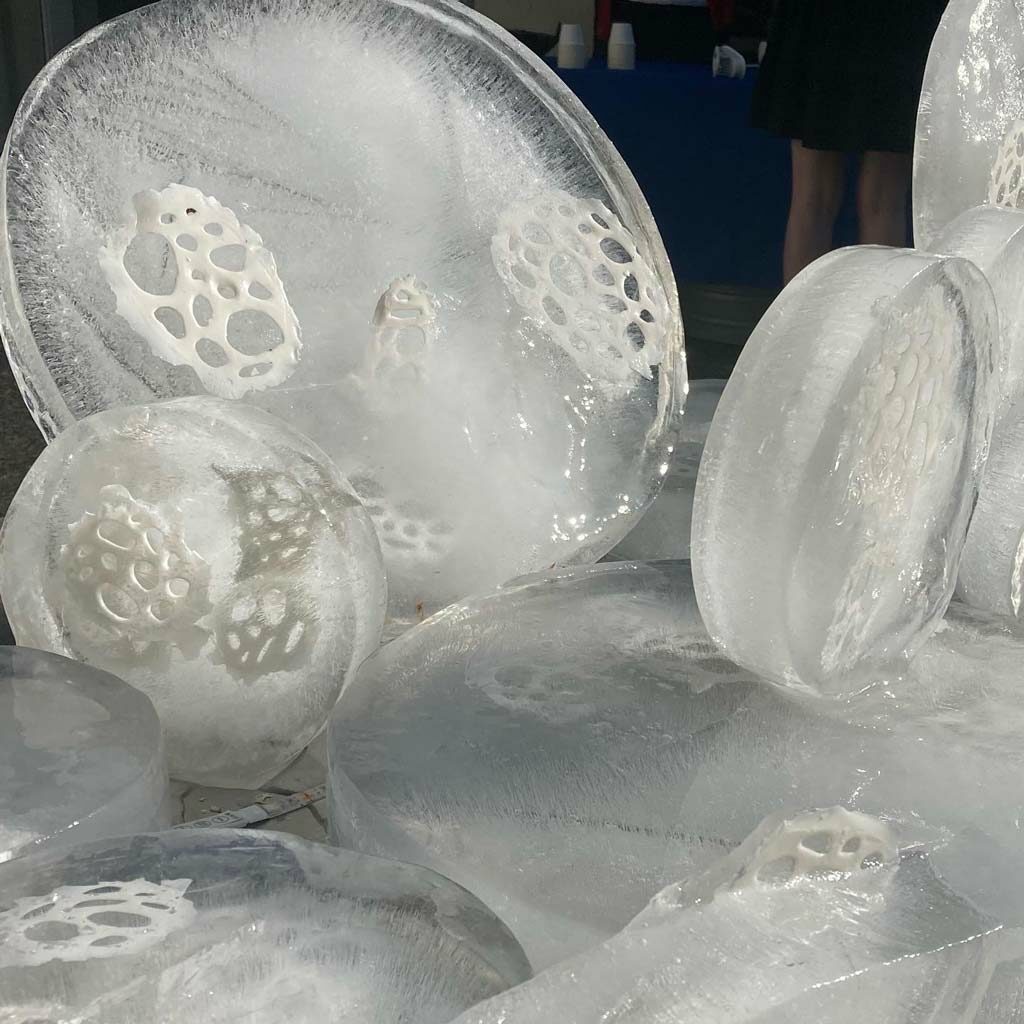
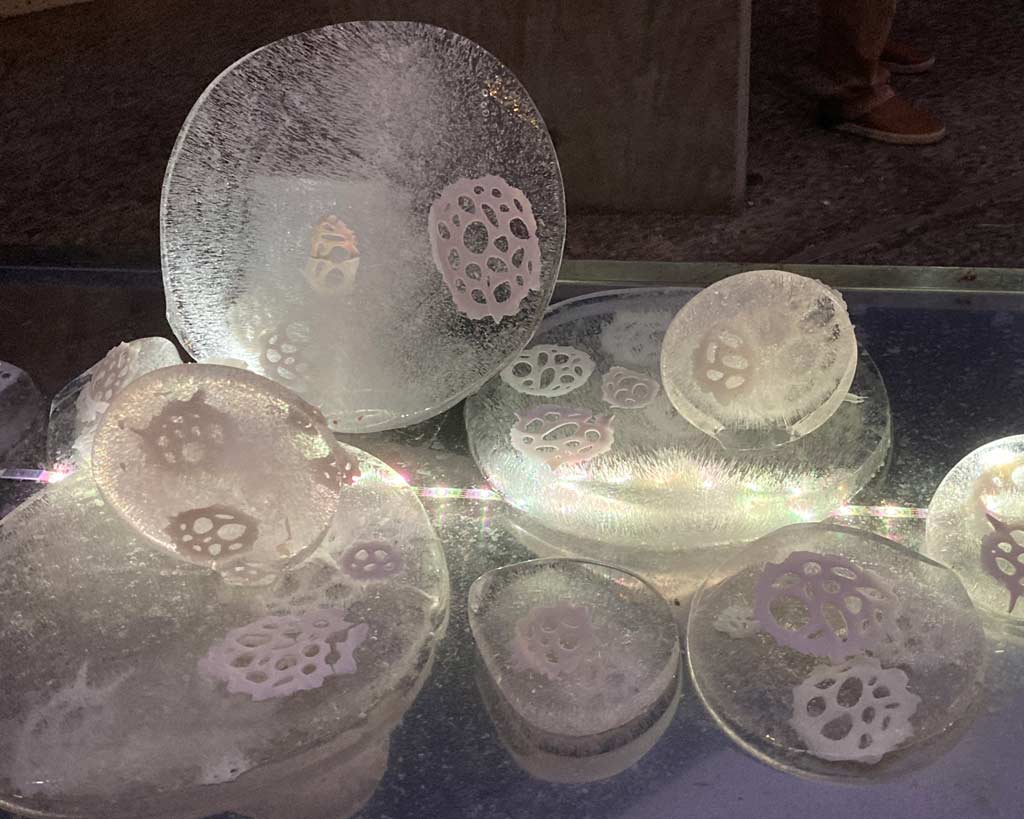
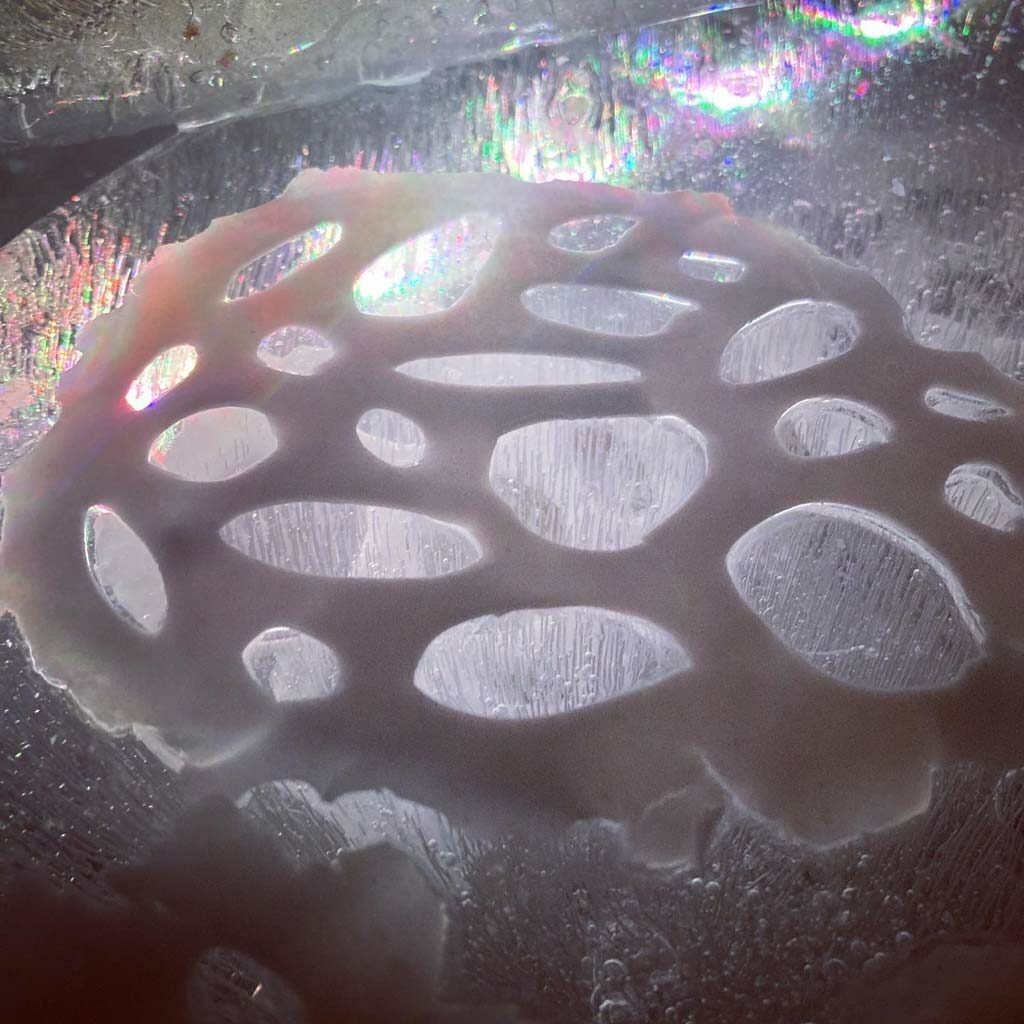
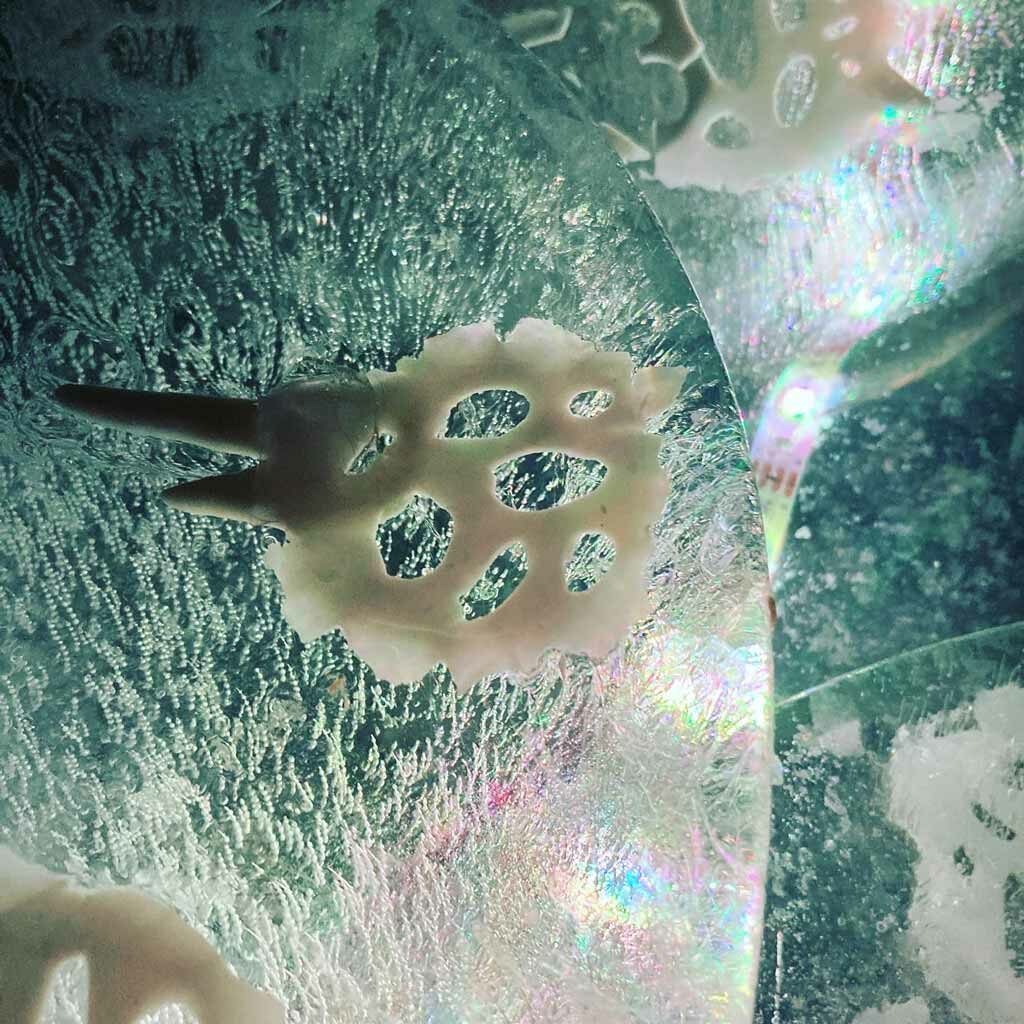
Still a few more things to do before we officially open on the 20th but this show is really coming together and I’m thrilled to share it with you…
Join me September 24th from 5 – 8 for the opening reception of
Bodies of Water
The studio will be open October 1, 2, 15 & 16, 2022 10am – 5pm | 2523 C Mission St Santa Cruz
Artist #26 in the catalog
For more information about this county wide event visit the Arts Council of Santa Cruz County
Beginning with a projected image on the wall, gives a starting place for the installation to launch from. The layout is based on satellite imagery of a plankton bloom happening in the Southern Ocean, near McMurdo Sound in Antartica. Ceramic pieces inspired by the skeletal structures of plankton were added to the wall giving it shape and dimension. Once the main form was installed the rest was done intuitively, adding one piece at a time and then stepping back to see it’s impact on the overall form. This piece is 30′ long by 8′ high and was installed over several days.
Come see it in person at Eloise Pickard Smith Gallery on the UCSC campus
Sept 20 – Dec 3, opening reception Sept 24 from 5-8
A few sneak peeks at what I’ve been installing at the Eloise Pickard Smith Gallery for my upcoming show Bodies of Water. The show is inspired by the unseen world of plankton, it’s beauty and it’s role in sustaining the planet.
We are bodies of water, we are connected to and dependent on the ocean from the very beginning of life on planet earth to our current day. Within all oceans are planktons, tiny marine drifters that make up the majority of all marine life in the ocean and are vital to sustain life on our planet. This exhibit aims to highlight the beauty of the unseen world of plankton, share the ecological importance of them and how we are connected.
The exhibit is on display Sept 20th – Dec 3rd 2022, with an opening reception Saturday September 24th from 5-8.
The gallery is open Tuesday, Wednesday, Friday, and Saturday from 12pm-5pm and Thursdays 12pm-7pm
We are bodies of water, we are connected to and dependent on the ocean from the very beginning of life on planet earth to our current day. With all the creatures that inhabit the oceans, we are easily awestruck by the sighting of a whale sliding across the surface to breathe before sinking to mysterious depths with one tail flip. It is equally easy to forget what it takes to sustain such large creatures and what they in turn give back to their own ecosystems to maintain a cycle in balance. Planktons are defined as marine drifters and while extremely tiny compared to whales, they make up 90% of the mass of all marine life in the ocean. They are vital to sustain all life on our planet, they signal changes in our climate, and yet these microscopic creatures are often overlooked and rarely strike us with awe. This exhibit aims to highlight the unseen world of plankton, share the ecological importance of them and how we are all connected.
Eloise Pickard Smith Gallery | University of California Santa Cruz
September 20 – December 3, 2022
Gallery Hours: 12 – 5 Tues, Wed, Fri, Sat & 1:30 – 7 Thurs
A parking pass can be acquired from the kiosk at the Bay St. campus entrance click here for a map
To purchase work from this exhibit: SHOP HERE
Happening this weekend at the Price Sculpture Forest on Whidbey Island!
One of the bigger parts of this upcoming exhibition is a site specific installation that is based on a NASA satellite image of a plankton bloom in Antarctica near McMurdo Sound. Even though the plankton are microscopic, there are so many of them in a large bloom, they can be seen from space, the color of the bloom all depends of the type of plankton.
The general form of the bloom laid out in circles was projected on the wall as a template to place all of the ceramic pieces. Some of the ceramic pieces are flat, some are raised off the wall and some are three dimensional forms, so there’s a lot of variation in the depth of the work. You can scroll through the photos below to see the progress I made.
As with all installations, things change and move based on how it’s working in the space, so I see some alterations ahead of me with this project but I’m sure it’s going to be beautiful once it’s done and all lit up. Stay tuned…
Bodies of Water | September 20 – December 3, 2022 | Opening Reception September 24th 5-8pm
Attention PNW Friends! You’ll want to save the date for this event!
I was thrilled to find out that my piece Lichen Series: Spore Patterns was selected as one of the sculptures in the Price Sculpture Forest for the dance event Wander/Wonder. Dancers from the StoneDance Productions will be interpreting and interacting with works in the forest through dance and music. I’m sad to not be able to see this in person but hope to get and share videos of the event. If you’re in the area, be sure to check it out!
StoneDance Productions presents WANDER/WONDER: a sculptured dance happening. Come journey on a lush forest trail to witness thought-provoking dance by 10 stunning professional Seattle dance artists alongside a beautiful outdoor collection of art.
Saturday, August 27, 2022 | 1:00-3:00pm | Price Sculpture Forest | 678 Parker Rd Coupeville, Whidbey Island, WA
Suggestion donation: $20 or pay-what-you-can. All donations accepted at the event. All proceeds from this event support the Whidbey Island Good Cheer Food Bank and Price Sculpture Forest.
For more information about this event visit: EVENT PAGE